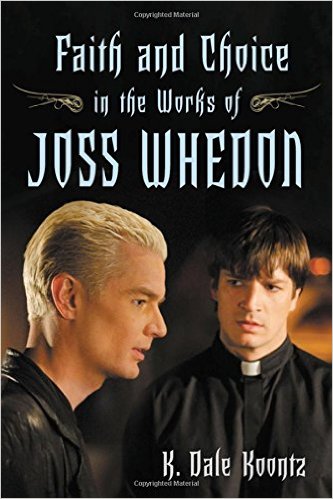Faith and Choice in the Works of Joss Whedon

Faith and Choice in the Works of Joss Whedon K. Dale Koontz. Jefferson, North Carolina: McFarland & Company, Inc., 2008. Softcover: vii +231. ISBN 978-0-7864-3476-3. $35.00.
Reviewed by Amy H. Sturgis
[This review originally appeared in Mythlore 27.3/4 (#105/106) (2009): 171–72.]
What do Earth-bound vampire slayers and cowboys in space have in common? In her new book about the worlds of Joss Whedon, K. Dale Koontz suggests that the answer is far deeper and more meaningful than witty writing and impressive special effects alone. Koontz is not the first author to analyze Joss Whedon’s Buffy universe (consisting of the Buffy the Vampire Slayer and Angel television series and their related texts) together with his Firefly universe (consisting of the Firefly television series, the film Serenity, and their related texts); some of those who anticipated her include J. Michael Richardson and J. Douglas Rabb with their book Existential Joss Whedon: Evil and Human Freedom in Buffy the Vampire Slayer, Angel, Firefly, and Serenity (McFarland: 2006) and Joy Davidson with her edited collection The Psychology of Joss Whedon: An Unauthorized Exploration of Buffy, Angel, and Firefly (BenBella: 2007). In Faith and Choice in the Works of Joss Whedon, however, Koontz also considers Whedon’s eight-issue comic series Fray, a futuristic tale related to but independent from the Buffy universe, thus expanding the landscape of Whedon studies. Unfortunately, one cannot help but think that Koontz’s volume debuted one year too early, because Whedon’s groundbreaking 2008 production Dr. Horrible’s Sing-Along Blog not only has proven to be one of his most popular and critically acclaimed creations, but also embodies the themes of choice and faith that are of most interest to Koontz.
Koontz’s purpose lies in examining why — and, more to the point, how — self-proclaimed atheist Joss Whedon underscores the themes of choice and faith in his works, themes that are undeniably spiritual in nature, if not tied to a specific religious tradition. While Koontz’s subject is compelling, she also implies that it is unique, and in so doing she misses a valuable opportunity to draw parallels between Whedon’s work and that of one of his contemporaries. Like Whedon, Chris Carter emphasizes questions of free will, redemption, and belief — often, like Whedon, invoking the symbolism of Roman Catholicism in particular while doing so — in creations such as The X-Files and Millennium, among others. The apparent paradox that Carter, an avowedly non-religious man, would devote so much attention to spiritual questions, and explore religious issues so perceptively, has been the focus of multiple analyses by critics. By ignoring the parallels between Whedon and Carter and failing to engage the scholarship on Carter’s work, Koontz loses the chance to make a larger comment on the contemporary creators behind and consumers of fantasy and science fiction media.
Despite these drawbacks, however, Koontz offers a valuable addition to Whedon studies. She divides her discussion into four sections. The first considers the theme of purpose through a close reading of the characters of Dawn, Spike, and Angel from the Buffy universe. The second focuses on the idea of family; Koontz begins by examining the way Whedon uses twin and sibling relationships in Fray and concludes by considering the atypical family represented by the crew and passengers in the Firefly universe. Third, Koontz presents her longest and most successful section, an extended exploration of how Whedon handles the concept of redemption via the characters of Doyle and Faith from the Buffy universe and Mal and Book Shepherd from the world of Firefly. Last, Koontz highlights zealotry as portrayed in the lives of River from Firefly and Caleb from Buffy. Throughout the chapters, Koontz spotlights what she considers to be the “ABCs” of Whedon’s storytelling: acceptance, belief, and choice.
Koontz’s familiarity with Whedon’s work allows her to move effortlessly among episodes and films and texts to draw three-dimensional and perceptive portraits of both the characters in question and the ideas they represent. At a few points she fails to match her encyclopedic knowledge of all things Whedon with an equally wide conception of spirituality; for the most part, Koontz limits herself to considering Whedon through the lens of Western Christianity, despite the overt and intentional presence of Buddhism, for example, in the Firefly universe. On the whole, however, Koontz makes a convincing case for the spiritual richness and artistic sophistication of Whedon’s creations, and thus a valuable contribution to scholarship on Whedon and in media studies. The reader is left with a deeper appreciation of Whedon’s faith — in the promise of goodness and in the potential of people, if not in a god — and the many ways in which he challenges and empowers his characters and, in turn, his fans to make moral choices with courage and compassion.

